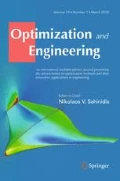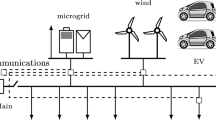Abstract
With the increasing share of renewable and distributed generation in electrical distribution systems, active network management (ANM) becomes a valuable option for a distribution system operator to operate his system in a secure and cost-effective way without relying solely on network reinforcement. ANM strategies are short-term policies that control the power injected by generators and/or taken off by loads in order to avoid congestion or voltage issues. While simple ANM strategies consist in curtailing temporary excess generation, more advanced strategies rather attempt to move the consumption of loads to anticipated periods of high renewable generation. However, such advanced strategies imply that the system operator has to solve large-scale optimal sequential decision-making problems under uncertainty. The problems are sequential for several reasons. For example, decisions taken at a given moment constrain the future decisions that can be taken, and decisions should be communicated to the actors of the system sufficiently in advance to grant them enough time for implementation. Uncertainty must be explicitly accounted for because neither demand nor generation can be accurately forecasted. We first formulate the ANM problem, which in addition to be sequential and uncertain, has a nonlinear nature stemming from the power flow equations and a discrete nature arising from the activation of power modulation signals. This ANM problem is then cast as a stochastic mixed-integer nonlinear program, as well as second-order cone and linear counterparts, for which we provide quantitative results using state of the art solvers and perform a sensitivity analysis over the size of the system, the amount of available flexibility, and the number of scenarios considered in the deterministic equivalent of the stochastic program. To foster further research on this problem, we make available at http://www.montefiore.ulg.ac.be/~anm/ three test beds based on distribution networks of 5, 33, and 77 buses. These test beds contain a simulator of the distribution system, with stochastic models for the generation and consumption devices, and callbacks to implement and test various ANM strategies.














Similar content being viewed by others
Notes
Under this approach, adequate investments in network components (i.e. lines, cables, transformers, etc.) must be made in order to always avoid congestion and voltage problems.
Network reinforcement is the process of upgrading the transmission capacity of lines, cables, transformers, and other devices. As distribution systems of interest in this paper are mostly done of underground cables, upgrading them implies a lot of infrastructure work.
Reported solution time can be larger than the time limit. It happens when the solver is executing a complex routine for some amount time before being able to check the limit.
References
Alguacil N, Conejo A (2000) Multiperiod optimal power flow using Benders decomposition. IEEE Trans Power Syst 15(1):196–201
Andersson G (2004) Modelling and analysis of electric power systems. EEH-Power Systems Laboratory, Swiss Federal Institute of Technology (ETH), Zürich
Bellman R (1957) Dynamic programming. Princeton University Press, Princeton
Bertsekas D, Shreve S (1978) Stochastic optimal control: the discrete time case. Academic Press, New York
Bertsekas D, Tsitsiklis J (1996) Neuro-dynamic programming. Athena Scientific, Belmont
Bishop C (2006) Pattern recognition and machine learning. Springer, Berlin
Bolognani S, Zampieri S (2016) On the existence and linear approximation of the power flow solution in power distribution networks. IEEE Trans Power Syst 31(1):163–172
Bonami P, Lee J (2006) BONMIN users manual. Tech. rep
Bose S, Gayme D, Mani Chandy K, Low S (2012) Quadratically constrained quadratic programs on acyclic graphs with application to power flow. ArXiv e-prints
Busoniu L, Babuska R, De Schutter B, Ernst D (2010) Reinforcement learning and dynamic programming using function approximators. CRC Press, Boca Raton
Busoniu L, Ernst D, De Schutter B, Babuska R (2011) Cross-entropy optimization of control policies with adaptive basis functions. IEEE Trans Syst Man Cybern B Cybern 41(1):196–209
Capitanescu F, Glavic M, Ernst D, Wehenkel L (2007) Interior-point based algorithms for the solution of optimal power flow problems. Electr Power Syst Res 77(5–6):508–517
Capitanescu F, Ochoa LF, Margossian H, Hatzargyriou ND (2015) Assessing the potential of network reconfiguration to improve distributed generation hosting capacity in active distribution systems. IEEE Trans Power Syst 1:346–356
Cornélusse B, Vangulick D, Glavic M, Ernst D (2015) Global capacity announcement of electrical distribution systems: a pragmatic approach. Sustain Energy Grids Netw 4:43–53
Defourny B, Ernst D, Wehenkel L (2011) Multistage stochastic programming: a scenario tree based approach to planning under uncertainty. Information Science Publishing, Hershey (Chap. 6:51)
Dolan MJ, Davidson EM, Kockar I, Ault GW, McArthur SDJ (2012) Distribution power flow management utilizing an online optimal power flow technique. IEEE Trans Power Syst 27(2):790–799
Dommel H, Tinney W (1968) Optimal power flow solutions. IEEE Trans Power Appar Syst PAS–87(10):1866–1876
Engelhardt S, Erlich I, Feltes C, Kretschmann J, Shewarega F (2011) Reactive power capability of wind turbines based on doubly fed induction generators. IEEE Trans Energy Convers 26(1):364–372
Fortuny-Amat J, McCarl B (1981) A representation and economic interpretation of a two-level programming problem. J Oper Res Soc 32:783–792
Fouquet D, Johansson T (2008) European renewable energy policy at crossroads—focus on electricity support mechanisms. Energy Policy 36(11):4079–4092
Gan L, Li N, Topcu U, Low S (2012) On the exactness of convex relaxation for optimal power flow in tree networks. In: Proceedings of the IEEE 51st annual conference on decision and control (CDC), pp 465–471
Gayme D, Topcu U (2011) Optimal power flow with distributed energy storage dynamics. In: Proceedings of the 2011 American control conference (ACC), pp 1536–1542
Gemine Q, Karangelos E, Ernst D, Cornélusse B (2013) Active network management: planning under uncertainty for exploiting load modulation. In: Proceedings of the 2013 IREP symposium—bulk power system dynamics and control—IX, p 9
Gemine Q, Ernst D, Louveaux Q, Cornélusse B (2014) Relaxations for multi-period optimal power flow problems with discrete decision variables. In: Proceedings of the 18th power systems computation conference (PSCC-14), p 7
Gemine Q, Cornélusse B, Glavic M, Fonteneau R, Ernst D (2016) A gaussian mixture approach to model stochastic processes in power systems. In: Proceedings of the 19th power systems computation conference (PSCC’16)
Gill S, Kockar I, Ault G (2014) Dynamic optimal power flow for active distribution networks. IEEE Trans Power Syst 29(1):121–131
Gopalakrishnan A, Raghunathan A, Nikovski D, Biegler L (2012) Global optimization of optimal power flow using a branch & bound algorithm. In: Proceedings of the 50th annual allerton conference on communication, control, and computing, pp 609–616
Gopalakrishnan A, Raghunathan A, Nikovski D, Biegler L (2013) Global optimization of multi-period optimal power flow. In: Proceedings of the 2013 American control conference (ACC), pp 1157–1164
Grelaud A, Robert C, Marin JM, Rodolphe F, Taly JF (2009) ABC likelihood-free methods for model choice in Gibbs random fields. Bayesian Anal 4(2):317–335
Hart W, Laird C, Watson JP, Woodruff D (2012) Pyomo-optimization modeling in Python, vol 67. Springer Science & Business Media, Berlin
Hastie T, Tibshirani R, Friedman J, Franklin J (2005) The elements of statistical learning: data mining, inference and prediction. Math Intell 27(2):83–85
Jabr RA (2006) Radial distribution load flow using conic programming. IEEE Trans Power Syst 21(3):1458–1459
Jones E, Oliphant T, Peterson P (2001) SciPy: open source scientific tools for Python. http://www.scipy.org/
Lavaei J, Low S (2012) Zero duality gap in optimal power flow problem. IEEE Trans Power Syst 27(1):92–107
Liew S, Strbac G (2002) Maximising penetration of wind generation in existing distribution networks. IET Gener Transm Distrib 149(3):256–262
Lopes J, Hatziargyriou N, Mutale J, Djapic P, Jenkins N (2007) Integrating distributed generation into electric power systems: a review of drivers, challenges and opportunities. Electr Power Syst Res 77(9):1189–1203
Macedo LH, Franco JF, Rider MJ, Romero R (2015) Optimal operation of distribution networks considering energy storage devices. IEEE Trans Smart Grid 6(6):2825–2836
Marin JM, Pudlo P, Robert C, Ryder R (2012) Approximate Bayesian computational methods. Stat Comput 22(6):1167–1180
Monticelli A (1999) State estimation in electric power systems: a generalized approach, vol 507. Springer Science & Business Media, Berlin
Ochoa L, Dent C, Harrison G (2010) Distribution network capacity assessment: variable DG and active networks. IEEE Trans Power Syst 25(1):87–95
Olivier F, Aristidou P, Ernst D, Van Cutsem T (2015) Active management of low-voltage networks for mitigating overvoltages due to photovoltaic units. IEEE Trans Smart Grid 7(2):926–936
Pedregosa F, Varoquaux G, Gramfort A, Michel V, Thirion B, Grisel O, Blondel M, Prettenhofer P, Weiss R, Dubourg V et al (2011) Scikit-learn: machine learning in Python. J Mach Learn Res 12:2825–2830
Phan D (2012) Lagrangian duality and branch-and-bound algorithms for optimal power flow. Oper Res 60(2):275–285
Powell W (2014) Clearing the jungle of stochastic optimization. In: Newman A, Leung J (eds.) Bridging data and decision, INFORMS, Catonsville, pp 109–137
Powell W (2016) A unified framework for optimization under uncertainty. Informs TutORials in Operations Research
Redner R, Walker H (1984) Mixture densities, maximum likelihood and the EM algorithm. SIAM Rev 26(2):195–239
SEDG Centre (2010) UK generic distribution system (UKGDS) project. http://www.sedg.ac.uk/
Shapiro A, Dentcheva D, Ruszczyński A (2009) Lectures on stochastic programming: modeling and theory. SIAM, Philadelphia
Soleimani Bidgoli H, Glavic M, Van Cutsem T (2016) Receding-horizon control of distributed generation to correct voltage or thermal violations and track desired schedules. In: Proceedings of the 19th power systems computation conference (PSCC 2016)
Wang DT, Ochoa LF, Harrison GP (2010) Dg impact on investment deferral: network planning and security of supply. IEEE Trans Power Syst 25(2):1134–1141
Acknowledgments
This research is supported by the public service of Wallonia—Department of Energy and Sustainable Building within the framework of the GREDOR project. The authors are grateful for the financial support of the Belgian Network DYSCO, an Inter-university Attraction Poles Program initiated by the Belgian State, Science Policy Office. The authors would also like to thank Raphaël Fonteneau for his helpful advice and comments.
Author information
Authors and Affiliations
Corresponding author
Rights and permissions
About this article
Cite this article
Gemine, Q., Ernst, D. & Cornélusse, B. Active network management for electrical distribution systems: problem formulation, benchmark, and approximate solution. Optim Eng 18, 587–629 (2017). https://doi.org/10.1007/s11081-016-9339-9
Received:
Revised:
Accepted:
Published:
Issue Date:
DOI: https://doi.org/10.1007/s11081-016-9339-9




